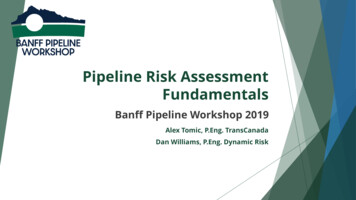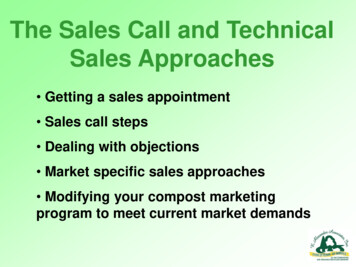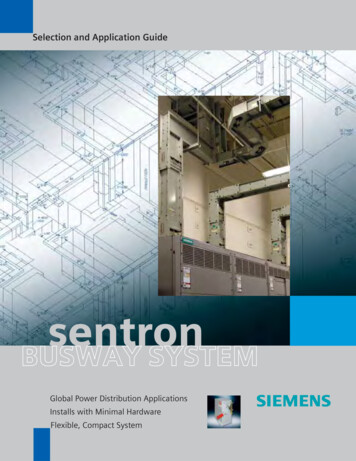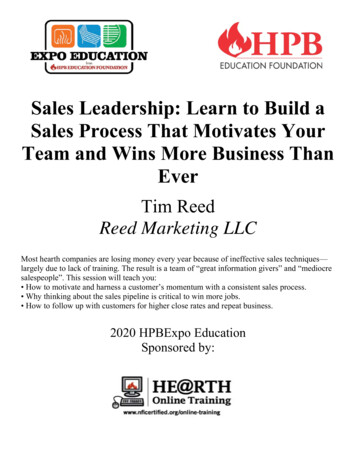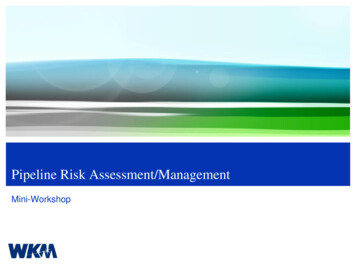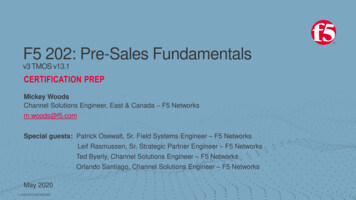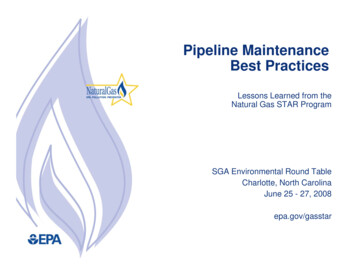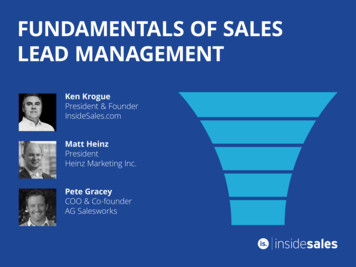
Transcription
FUNDAMENTALS OF SALESLEAD MANAGEMENTKen Krogue President & FounderInsideSales.comMatt Heinz PresidentHeinz Marketing Inc.Pete Gracey COO & Co-founderAG Salesworks
Introductionfrom Ken KrogueThe next time one of your salespeopleyells, “Show me the money,” shout rightback, “Show me the metrics.” Effectivesales pipeline management begins withthe right data.Matt Heinz, Pete Gracey and I puttogether a webinar on sales pipelinemanagement. We show you how tocalculate how many leads and opportunities you need to achieve your salesgoals, and other best practices. We allget asked about these topics so oftenthat we decided to package these valuable insights into this ebook.Matt shares some eye-popping stats thathighlight the value of lead nurturing. Hereminds us that 60 percent to 65 percentof inbound leads are qualified but notready to buy. He provides some practicaltips for treating these leads like longterm prospects and guiding them downthe sales funnel.Page 2Matt also offers up a proven frameworkfor documenting your lead managementprocess. You can do this by answering aseries of crucial questions, such as: Howdoes a new lead get assigned? What arethe assignment rules? How will we followup on each lead? What’s the follow-upmessage? Plus a few more.I had a lot of fun doing the webinar withMatt and Pete. They’re masters at salespipeline management. I’ve learned a lotfrom both of them. I’m sure you’ll findtheir sales wisdom useful, too. You canwatch the webinar here.Pete reveals the power of using socialintelligence to target prospects andnudge them further down the funnel. Hepoints out that automated email campaigns aren’t simply a marketing tactic.He shows you how your sales team cantake advantage of automated emails tonurture prospects with relevant content.Ken Krogue President & Founder,InsideSales.comHappy selling,I walk you through the seven rules forimproving contact ratios with busy decision makers. And we explore ways tocreate urgency and leverage triggerevents to close deals faster.InsideSales.com Heinz Marketing AG SalesworksShare this eBook:
Table of ContentsPage 3About the Authors 5Published by InsidesSales.com34 East 1700 SouthProvo, Utah 84606877-798-9633Pipeline BasicsCopyright 2015 All Rights ReservedIntroduction From Ken Krogue 2Metrics 6People and Problems, Not Products 6Prospect Engagement Funnel 7Leads and Opportunities 8Managing Referral Sources 8Lead Management Process 9Lead Scoring and Steps 9InsideSales.com Heinz Marketing AG SalesworksShare this eBook:
Table of ContentsPage 45 Steps to Managing Your PipelineSeven Rules of ContactWhat Happens After Success? 10Seven Rules of Contact With Your Pipeline 15Step 1. Tactical Outbound Messaging 10Immediacy 15Step 2. Email Marketing Automation 10Persistency 15Step 3. Fully-Qualified Lead Delivery 11Optimal Call Times 15Step 4. Closed Loop Feedback 11Time of Day 16Step 5. ROI Analysis 12Day of Week 16Direct Dial 16Learn the VariablesCaller ID 16Summary & Credits 18Key Players 13ANUM 13Circle of Influence 14Primary Qualifiers 14Urgency 14Trigger Events 14InsideSales.com Heinz Marketing AG SalesworksShare this eBook:
Page 5About the AuthorsKen KrogueMatt HeinzPete GraceyPresident & founderPresidentCOO & Co-founderInsideSales.com—insidesales.comKen currently leads the Business Development,Consulting, Education, Implementation andSupport departments at InsideSales.com. Hebrings more than twenty-four years of experience in sales, development and marketing inboth domestic and international markets andis a weekly contributor to Forbes.com. Hisblog is the top-ranked blog in the world onthe topic of inside sales.Heinz Marketing Inc.—heinzmarketing.comMatt brings more than fifteen years of marketing, business development and salesexperience from a wide range of organizations, verticals and company sizes. He’s heldleadership positions at Microsoft, WeberShandwick, Boeing, The Seattle Mariners,Market Leader and Verdiem. In 2007, Mattlaunched Heinz Marketing to help clientsfocus their business and customer opportunities and then scale a plan to execute theirrevenue and customer growth.InsideSales.com Heinz Marketing AG SalesworksAG Salesworks—agsalesworks.comPete founded AG Salesworks back in 2002with his partner, Paul Alves. Their goal was toprovide technology to companies with highquality and fully-qualified sales leads. In hiscurrent position, Pete oversees daily operations of AG Salesworks, which includes clientengagement, personnel management, business strategy and across the board dataanalysis with long-term strategic planning. Heis a prolific blogger, frequently posting to thecompany’s website and also contributing toonline video presentations.Share this eBook:
Page 6Pipeline BasicsMetricsSales pipelines begin with the metrics.It’s difficult to manage a sales pipelinewithout knowing what you need. Weuse a very simple pipeline calculation inwhich we take into account questionslike: How many sales do you need? Howmany opportunities do you need to getthere? How many leads do you need toget to that number of opportunities?I often find companies that have a certain revenue number in mind haven’tdone the accurate math on how manyopportunities are needed in order to hitthat number. Between 25 and 33 percentof opportunities in a B2B environmentwill close at the expected close date. Forevery three to four opportunities, onewill close, and only 5 to 10 percent ofqualified leads will actually turn into anopportunity. If you do the math, you veryquickly get a sense for the scale of thework needed.People and Problems,Not ProductsWe need to focus on people and problems, not products. When you’re buildinga marketing plan, I highly recommendyou do it with five questions that arefairly straightforward and that focus onthe prospect.Marketing Plan in 5 Questions1. What/Who is your target?2. What do they care about? What outcome are they seeking?3. Where do you find them?4. What or who influences them?5. How do they want to engage and(eventually) buy?to know about this person to converthim into an opportunity? He may be thedirect target you want to get to, but it’salso important to understand the entireecosystem you are selling into. Everyonewithin the company has a different rolewith different ideas and approaches tothe same problem. Instead of talkingabout your solution, speak to the problem that already exists. Translate yourmessage into their needs. In some cases,the company knows it has a problem, inother cases, it doesn’t. If you can educate a company on a problem it didn’tknow existed and you can quantify it,then you’re getting somewhere.At the beginning of any sales or marketing challenge, we at Heinz Marketing askourselves what success looks like and towhom we are selling. What do we needInsideSales.com Heinz Marketing AG SalesworksShare this eBook:
Page 7Pipeline BasicsProspect EngagementFunnelMost companies want to take their prospects, put them in a sales cycle and turnthem into new customers. Marketing tellsus that for inbound leads, only 10 to 15percent are qualified and ready to buy.60 to 65 percent are qualified but notready to buy.Most sales and marketing organizationstreat these prospects the same way. Theygive all the leads to sales. Sales follows up,finds that the vast majority are not readyto buy, and then nothing happens withthat audience. This is where you get intodrip marketing. Nothing fancy involved inthis. Marketing automation is helpful, notnecessary. The important thing is to realizemost prospects are going to be long-termprospects who need to be nurtured. Twitter, Facebook and other social media canbe used as early relationship builders.InsideSales.com Heinz Marketing AG SalesworksCustomer Targets (based on persona profiles)Network / Open CommunityChannels: Twitter, Facebook, Blog, LinkedInGoal: Drive RegistrationDrip MarketingChannels: Email Newsletters, CRM SystemGoal: Drive Active ProspectsActive Sales CycleChannels: CRM, 1:1Goal: SellNewCustomerShare this eBook:
Page 8Pipeline BasicsProductivityThere are different stages of an inboundlead. At Heinz Marketing, we’ve definedwhat it means to be at each of thosestages, and we have a next step and specific action items for sales and marketingat each stage. It’s especially important toknow the difference between a qualifiedlead and a new opportunity. Enumerating that difference is the most importantpart of driving better sales and marketing alignment.Managing ReferralSourcesIt’s important to manage referralsources. I recommend ranking yourreferral partners on a two-part scale. Ona 1-4 ranking, rank their importance toImportanceLeads andOpportunities1. Proactive2. Reactive3. Minimal4. Dark1. EliteMonthly meetingsJoint pipelineGistTwitterMonthly meeting/callGistTwitterBi-monthly callGistTwitterQuarterly callGistTwitter2. GoodBi-monthlymeetingsJoint pipelineGistTwitterMonthly callsGistTwitterQuarterly callGistQuarterly call3. OccasionalQuarterly meetingsGistQuarterly callEmail onlyEmail only4. MinimalEmail onlyEmail onlyEmail onlyEmail onlyyou and their level of productivity. WhatI mean by importance is, how good arethe leads they’re bringing to you? Andin terms of productivity, how active andhow proactive are they at bringing thoseleads to you? With some referral sourcesyou may just do an email update fromInsideSales.com Heinz Marketing AG Salesworkstime to time. But for referral partnerswho bring you elite leads and are proactive about doing it, you may be veryaggressive. You will probably find thatyou spend the majority of your time withthe minority of your referral partners.Share this eBook:
Page 9Pipeline BasicsLead ManagementProcessLead Scoring andStepsI also encourage you to have a strongsense of what you’re going to do withincoming leads. You need to have adocumented process for what happensto a lead in each stage. How does it getassigned? What are the assignment rulesof those leads? What’s the expectationof how it will be followed up? What’s thefollow-up message? Who’s writing thatmessage? Who’s delivering that message? What happens next based onwhatever reaction the prospect has tothat message? It may look like a complicated process, but if you don’t have aprocess like this, it’s very difficult to besure you’re consistently and entirely getting all the value from the leads you’regenerating.Not every lead is created equal. Someleads will tell you they’re qualified andready to buy, some will not. There areways you can score leads based on theirresponse to campaigns and activity withyour content. Even if you don’t have marketing automation systems, you can dobasic lead scoring based on responsesto campaigns. And you can do a lot of itwithin Salesforce and its campaign tools.Stepping back and thinking about whatyour strategy is for managing the overallpipeline is what is important. The toolsare merely tools.InsideSales.com Heinz Marketing AG SalesworksShare this eBook:
5 Steps toManaging Your PipelineWhat Happens AfterSuccess?What happens when you are successful?Imagine your message has gotten outthere. Your campaigns are working andnow you have an active marketplace thatrequires you to prospect further. Nowwhat? There are five things you needto think about when you’re about toembark on or are currently teleprospecting your ideal customer profile.Page 10Step 1. Tactical Outbound MessagingBefore you go looking for fully-qualified opportunities to get on the phone, takespecial care deciding what you’re actually going to say to them. We call this tactical outbound messaging. When you are thinking about what a fully-qualified lead is,there’s one operative word to keep in mind: pain. You’ve got to establish the specificpains you can solve for a client with your technology and make sure your tacticaloutbound messaging is personalized to that pain. Make sure you’re using all theresources at your disposal to know what to say to them and when to say it.Social intelligence can also be huge in terms of tracking prospects throughout theircareers and leveraging that information. Leverage all the tools that are at your disposal, focus on pain, and create a tight message. This will allow you to get as manypeople live on the phone for meaningful conversations as possible.Step 2. Email Marketing AutomationOrganizations are doing an exceptionally good job at the top of the funnel with theirmarketing automation solutions. But this great technology, which automates a verycumbersome process, falls off the map when a lead gets into the hands of a teleprospecting rep. This shouldn’t happen. Every one of your reps who is outboundingshould have an individual instance of your marketing automation solutions fixedinto his or her teleprospecting plan. Don’t stop incorporating your overall corporatecampaigns just because someone has gotten into the middle stages of your salesInsideSales.com Heinz Marketing AG SalesworksShare this eBook:
5 Steps toManaging Your Pipelinewaterfall. Keep the content flowing. Keep the automation in place all the way throughout the process, until there’s a point in time where your sales team has indicated thatthis person is so close there’s no need to be communicating with them in an automated capacity.Step 3. Fully-Qualified Lead DeliveryNone of what I’ve mentioned matters if you don’t have a tight definition of what afully-qualified lead is. Establish within your teleprospecting organization a definitionand adhere to it religiously. At AG Salesworks we talk about having deep and relevantpain. You must be able to solve the issues within that organization and you’ve got tobe able to talk to a decision maker. This prospect then needs to voice how much thatpain is costing the company and how much the organization is willing to spend annually to solve those pains. Then, you schedule an introductory conference call betweenthe teleprospecting rep, the fully-qualified prospect and your sales representativeor account manager. Have your teleprospecting rep on that call and have him or herintroduce your sales rep as the expert that is still needed in this process. After thatcall, the sales team should then assume all responsibility for managing that relationship. But it’s important that you define what a fully-qualified lead is, you stick to it andyou make sure you’re helping your salespeople by facilitating that first scheduled callthat you book on their behalf.InsideSales.com Heinz Marketing AG SalesworksPage 11Step 4. Closed LoopFeedbackWhile this process is good, it all fallsapart if you don’t have closed loop feedback in place. If you don’t find out threecritical things from your sales rep aboutthat first call, you could be in big trouble.Those three critical things are: Did thecall occur? Was the qualification criteriavalid? and Is there a logical next step inyour sales process? A logical next step inyour sales process is not a follow-up callin six months. It’s an onsite in two weeks.You want between 70 to 90 percent ofthe calls you book to occur. 90 to 100percent of the information gatheredneeds to be validated. In our case, weleverage InsideSales.com from a callrecording standpoint, so that we canShare this eBook:
5 Steps toManaging Your Pipelineback that information up. And then on the next step in the process, 80-90 percent ofthe calls that occur with the information validated should have a logical next step. AtAG we term that Stage 1 Pipeline.Step 5. ROI AnalysisNow you’ve got to actually close the loop and figure out whether or not you’re achieving ROI. There is a way early on in your teleprospecting campaign to figure outwhether you’re achieving ROI. In a 90 day period, for every Stage 1 Pipeline opportunity your teleprospecting team generates, assign your organization’s average annualsales ticket or average deal value to that opportunity and total that up over time. At aminimum, in those first 90 days you need to see at least 50x of your teleprospectinginvestment in the form of that Stage 1 Pipeline. Over time you want over 50 percentof those leads converting to much deeper stages of your sales forecast. And ultimately you have to decide if there’s an adequate amount of closed business to justifythe expense.InsideSales.com Heinz Marketing AG SalesworksShare this eBook:Page 12
Page 13Learn the VariablesKey PlayersWhile there is a lot of data to go through,the variables themselves don’t startwith the data. They start with yourkey players. Recently we got our bestsalespeople in one room, and we wereamazed with what we found. We hadstrayed a little bit, but after we dialedback the results went up again within afew days. You have to keep your eye onthe ball and listen to your key players.ANUMNext you look at the data. What is a formula for a qualified lead? In the old daysit was BANT. However, nowadays starting with the budget is like asking for W2son the first date. It’s not the appropriate way to qualify early on. DemandGensaid in a 2010 research study for Geniusthat only 20 percent of companies evenset annual budgets anymore by whichthey make their purchase decisions.While you need to qualify for money, itshould no longer be your first step. Inthe newer model, the ANUM model,you start with finding the person withauthority to make the decision. Thencomes need. The challenge your salespeople will face is most customers don’trealize they need your product, so youhave to educate. But believe me, if theneed is strong enough, the urgency andBudgetAuthorityNeedTimingInsideSales.com Heinz Marketing AG Salesworksthe money will appear. Don’t fall forthe common methodology of qualification I call the RANDUM model. In thismodel there is rarely any need, decisionmaking, urgency or money built into theprocess at all. The ANUM model is thesame methodology you should be usingin your pipeline forecasting. If thoseelements are there, you
within Salesforce and its campaign tools. Stepping back and thinking about what your strategy is for managing the overall pipeline is what is important. The tools are merely tools. Pipeline Basics: . Fundamentals of Sales Pipeline Management InsideSales.com .
